Chain stitch
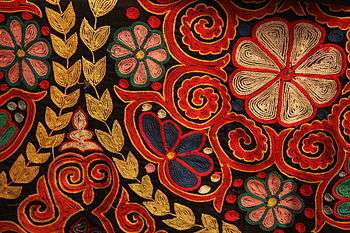
Chain stitch is a sewing and embroidery technique in which a series of looped stitches form a chain-like pattern.[1] Chain stitch is an ancient craft – examples of surviving Chinese chain stitch embroidery worked in silk thread have been dated to the Warring States period (5th – 3rd century BC).[2] Handmade chain stitch embroidery does not require that the needle pass through more than one layer of fabric. For this reason the stitch is an effective surface embellishment near seams on finished fabric. Because chain stitches can form flowing, curved lines, they are used in many surface embroidery styles that mimic "drawing" in thread.[3]
Chain stitches are also used in making tambour lace, needlelace, macramé and crochet.
History
The earliest archaeological evidence of chain stitch embroidery dates from 1100 BC in China. Excavated from royal tombs, the embroidery was made using threads of silk.[4] Chain stitch embroidery has also been found dating to the Warring States period. Chain stitch designs spread to Iran through the Silk Road.[5]
Applications

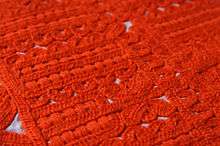
Hand embroidery
Chain stitch and its variations are fundamental to embroidery traditions of many cultures, including Kashmiri numdahs, Iranian Resht work, Central Asian suzani, Hungarian Kalotaszeg "written embroidery",[6] Jacobean embroidery, and crewelwork.
Machine sewing and embroidery
Chain stitch was the stitch used by early sewing machines; however, as it is easily unravelled from fabric, this was soon replaced with the more secure lockstitch. This ease of unraveling of the single-thread chain stitch, more specifically known as ISO 4915:1991 stitch 101, continues to be exploited for industrial purposes in the closure of bags for bulk products.[7][8]
Machine embroidery in chain stitch, often in traditional hand-worked crewel designs, is found on curtains, bed linens, and upholstery fabrics.
Variants
Hand variants
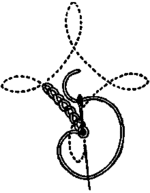
Variations of the basic chain stitch include:
- Back-stitched chain stitch
- Braided stitching
- Cable chain stitch
- Knotted chain stitch
- Open chain stitch
- Petal chain stitch
- Rosette chain stitch
- Singalese chain stitch
- Twisted chain stitch
- Wheat-ear stitch
- Zig-zag chain stitch
Hand stitch gallery
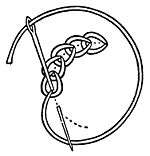 Basic chain stitch
Basic chain stitch Braid stitch
Braid stitch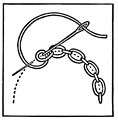 Cable chain stitch
Cable chain stitch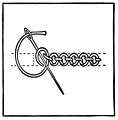 Knotted chain stitch
Knotted chain stitch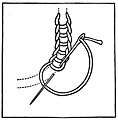 Open chain stitch
Open chain stitch Petal chain stitch
Petal chain stitch Rosette chain stitch
Rosette chain stitch Rosette chain line
Rosette chain line Singalese chain stitch
Singalese chain stitch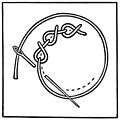 Twisted chain stitch
Twisted chain stitch Wheat-ear stitch
Wheat-ear stitch Zig-zag chain stitch
Zig-zag chain stitch
Machine variants
- The Basic Chain stitch is made by first sending the needle down through the material. Then, as the needle rises upward, the friction of the thread against the fabric is sufficient to form a small loop on the underside of the material. That loop is caught by a circular needle which is beneath the work. The machine then moves the material forward projecting the loop on the underside from the previous stitch. The next drop of the needle goes through the previous loop. The circular needle then releases the first loop and picks up the new loop and the process repeats.[9]
- The Double chain stitch uses two threads. It is rarely used in today's machines except for ornamental purposes because it uses a lot of thread.[9] It is found in bulk material packaging, where it is used to close big bags. In this case it is useful to allow an easy opening of the bag.
Machine stitch gallery


 Basic chain stitch
Basic chain stitch Double chain stitch
Double chain stitch
Notes
- ↑ Reader's Digest Complete Guide to Needlework. The Reader's Digest Association, Inc. (March 1992). ISBN 0-89577-059-8, p. 32-33
- ↑ Gillow, John, and Bryan Sentance: World Textiles, Bulfinch Press/Little, Brown, 1999, ISBN 0-8212-2621-5, p. 178
- ↑ Gillow and Sentance: World Textiles, p. 178
- ↑ Mary Schoeser (2007). Silk. Yale University Press. p. 18. ISBN 978-0-300-11741-7. Retrieved 15 January 2013.
from the same dates comes the earliest evidence of chain stitch embroidery, worked with silk threads
- ↑ Catherine Amoroso Leslie. Needlework Through History: An Encyclopedia. Greenwood Publishing Group. p. 41. ISBN 978-0-313-33548-8.
- ↑ Gillow and Sentance: World Textiles, p. 178-179
- ↑ Union Special, Closing Machines BC100 and 80800 (PDF), p. 2, archived from the original (PDF) on 2011-07-19, retrieved 2009-05-26
- ↑ American & Efird, ISO Stitch Terminology (PDF), p. 1, archived from the original (PDF) on 2009-03-26, retrieved 2009-05-28
- 1 2 1902 Encyclopedia
Union Special Portable Chain Stitch machine internal mechanism 2200 Portable bag closing machines
See also
References
- Virginia Churchill Bath, Needlework in America, Viking Press, 1979 ISBN 0-670-50575-7
- S.F.A. Caulfield and B.C. Saward, The Dictionary of Needlework, 1885.
- Mrs. Archibald Christie. Samplers and Stitches, a handbook of the embroiderer's art, London 1920, 1989 facsimile: Batsford, ISBN 0-7134-4796-6, or online at Project Gutenberg
- John Gillow and Bryan Sentance: World Textiles, Bulfinch Press/Little, Brown, 1999, ISBN 0-8212-2621-5
- Reader's Digest Complete Guide to Needlework. The Reader's Digest Association, Inc., March 1992, ISBN 0-89577-059-8


